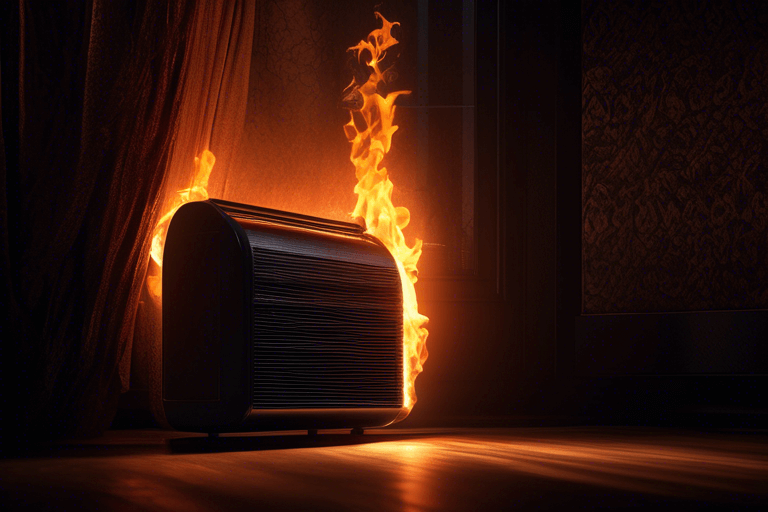
How Hot Does Something Have to Be to Catch Fire?
When it comes to fire safety, it can be helpful to understand the temperature at which common objects can catch fire. Whether it's wood, paper, or other materials, knowing their ignition temperature can help prevent accidents and ensure the safety of people and property.
In this article, we will explore the ignition temperatures of various substances and delve into the science behind combustion.
Understanding Ignition Temperature
The ignition temperature, also known as the kindling point, is the minimum temperature at which a substance can spontaneously ignite without the need for an external ignition source, such as an open flame.
It is the point at which the heat energy supplied to a material is sufficient to initiate and sustain a combustion reaction.
It's important to note that different materials have different ignition temperatures. For example, wood, paper, and flammable liquids each have their own unique ignition points.
Let's take a closer look at some common materials and their respective ignition temperatures.
Wood Ignition Temperature
Wood is a widely used building material, making it essential to understand its ignition temperature. The ignition temperature of wood varies depending on several factors, including the type of wood, its moisture content, and the presence of other flammable materials.
In general, wood ignites at temperatures ranging from 450 to 500 degrees Fahrenheit (232 to 260 degrees Celsius). At oven temperatures of around 450 to 500 degrees Fahrenheit, wood gradually chars and may eventually catch fire after several hours.
However, it's important to note that the exact ignition temperature of wood can vary based on its specific characteristics.
Paper Ignition Temperature
Similar to wood, paper is a combustible material that can easily catch fire under certain conditions. The ignition temperature of paper also depends on various factors, such as its composition, thickness, and exposure to heat sources.
While there is no precise ignition temperature for paper due to its varying characteristics, research suggests that the ignition temperature of paper ranges from 450 to 500 degrees Fahrenheit (232 to 260 degrees Celsius).
However, it's worth noting that glossy paper, which is often coated with a plastic layer, may require a higher temperature for ignition.
Flammable Liquids Ignition Temperature
Flammable liquids, such as gasoline, alcohol, and solvents, have lower ignition temperatures compared to solid materials like wood and paper. These liquids have the ability to release flammable vapors, which can ignite at relatively low temperatures.
The ignition temperature of flammable liquids varies depending on their specific chemical composition.
For example, gasoline has an ignition temperature of approximately -45 degrees Fahrenheit (-43 degrees Celsius), while alcohol has an ignition temperature of around 495 degrees Fahrenheit (257 degrees Celsius).
It's important to handle and store flammable liquids with caution, ensuring they are kept away from potential ignition sources and stored in appropriate containers.
Factors Affecting Ignition Temperature
While ignition temperatures provide a general guideline, it's essential to understand that various factors can influence the ignition of materials.
These factors can affect the temperature at which a substance catches fire and the speed at which combustion occurs. Let's explore some of the key factors that can impact ignition temperature:
Moisture Content
The moisture content of a material, such as wood or paper, can significantly affect its ignition temperature. Moisture acts as a heat sink, absorbing heat energy and making it more challenging for the material to reach its ignition point.
Dry materials tend to have lower ignition temperatures as they lack moisture to dissipate heat. On the other hand, wet or damp materials require a higher temperature to overcome the heat sink effect of moisture and ignite.
Chemical Composition
The chemical composition of a substance plays a crucial role in determining its ignition temperature. Different chemical compounds have varying levels of flammability and reactivity, affecting their susceptibility to ignition.
For example, certain additives or coatings applied to paper can alter its ignition temperature. Glossy paper, which is coated with a thin layer of plastic, requires a higher temperature for ignition compared to regular paper.
Heat Source
The intensity and proximity of the heat source to a material can significantly impact its ignition temperature. Direct contact with a high-temperature heat source, such as an open flame, can raise the temperature of the material rapidly, increasing the likelihood of ignition.
Indirect heat sources, such as hot surfaces or radiant heat, can also contribute to the ignition of materials. For instance, wooden flooring in contact with steam pipes can gradually heat up over time and eventually catch fire if exposed to high temperatures for extended periods.
Environmental Conditions
Environmental conditions, such as ambient temperature and the presence of oxygen, can influence the ignition temperature of materials. Higher ambient temperatures can lower the ignition temperature, making it easier for materials to catch fire.
The availability of oxygen is also critical for combustion to occur. In the presence of oxygen, materials can burn more readily, requiring lower ignition temperatures.
Oxygen-deprived environments, such as confined spaces, may necessitate higher ignition temperatures for materials to ignite.
Safety Measures and Fire Prevention
Understanding the ignition temperatures of various materials is essential for fire safety and prevention. By knowing the specific ignition points of materials, appropriate precautions can be taken to minimize the risk of fires.
Here are some safety measures and fire prevention strategies:
Safe Storage and Handling
When dealing with flammable materials, it's crucial to store them properly in designated containers and areas away from potential ignition sources.
Follow safety guidelines and regulations for storing flammable liquids, ensuring proper ventilation and fire suppression systems are in place.
Fire-Resistant Materials
Using fire-resistant building materials in construction can help mitigate the risk of fire spread and reduce the likelihood of ignition. Valuable items and important documents should be kept in fire-rated safes or fireproof bags (see how these two options compare).
Fire-resistant safes are designed to withstand high temperatures for extended periods, providing vital protection of your valuables until the fire moves on or is extinguished via firefighting efforts.
Fire Safety Training
In business environments, providing comprehensive fire safety training to individuals, including employees and residents, can increase awareness and promote safe practices.
Training should cover topics such as fire prevention, evacuation procedures, and the proper use of fire extinguishers.
Fire Detection and Suppression Systems
Installing reliable fire detection and suppression systems, such as smoke detectors, fire alarms, and sprinkler systems, is crucial for early fire detection and swift response.
These systems can help minimize the spread of fire and ensure prompt evacuation.
Regular Inspections and Maintenance
Regular inspections and maintenance of fire safety equipment, electrical systems, and heating sources are essential to identify potential hazards and address them promptly.
This includes checking for damaged wiring, malfunctioning appliances, and ensuring proper ventilation in enclosed spaces.
Be Informed
Knowing the ignition temperature of materials is vital for fire safety and prevention. Understanding the specific ignition points of wood, paper, and flammable liquids allows for the implementation of appropriate safety measures and precautions.
By storing materials correctly, using fire-resistant materials, providing fire safety training, and installing reliable detection and suppression systems, the risk of fires can be significantly reduced.
Remember, fire safety is everyone's responsibility, and taking proactive measures can save lives and protect property.




